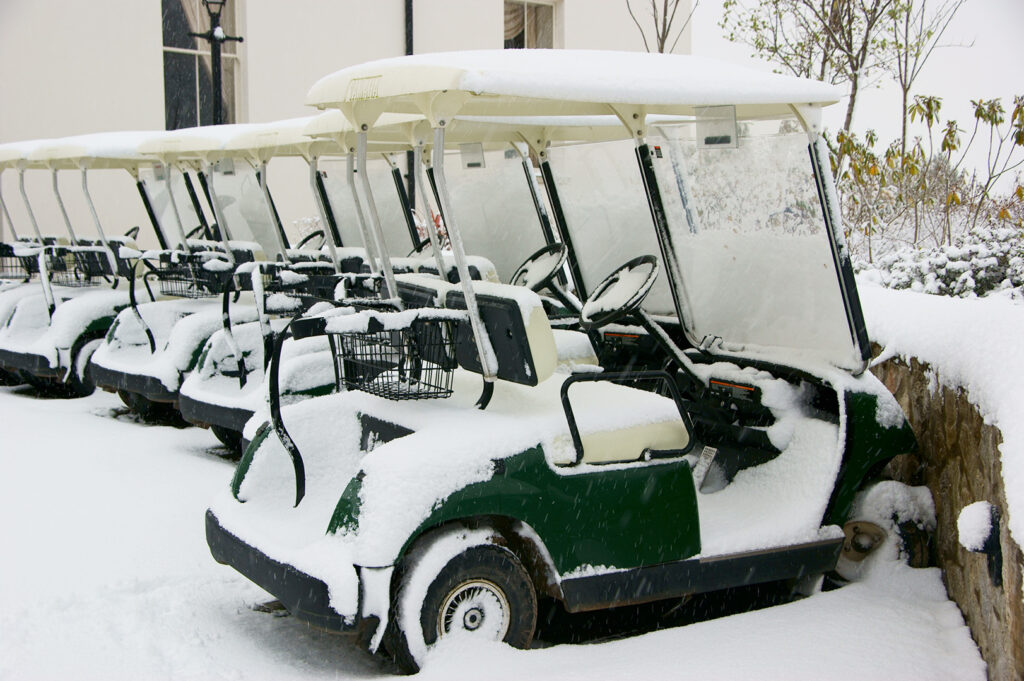As colder temperatures approach, it’s a good time to start preparing your deep-cyle golf car batteries for proper operation or long-term storage during winter. There are various types of battery technologies, and each one performs differently in cold weather. Because of this, it’s important to know the differences and how to prepare them for a long winter.
PREPARING FOR STORAGE
No matter what battery technology you are using, Lithium Ion (Li), Flooded Lead Acid (FLA), or Absorbed Glass Mat (AGM), if you are planning on storing these batteries for the winter, the first thing to do is to charge them fully. A full charge before long-term cold storage prevents the electrolyte from freezing, expanding, and cracking the battery case for FLA batteries. A fully charged FLA battery has a freezing point below -80°F (-62°C), while a discharged battery has a freezing point of 20°F (-6.7°C) or higher.
In AGM batteries, the electrolyte is ‘absorbed’ in the separators and electrodes; however, it is still a liquid and susceptible to freezing. So, for long-term storage in cold conditions, AGM lead batteries should be fully charged before storing and even maintained at a high state of charge during storage. Since AGM batteries are sealed, and specific gravity cannot be measured, the best way to determine the state of charge is to check the open circuit voltage with a voltmeter. Check with the battery manufacturer’s specifications to determine the voltage at full charge. It is important to recognize that all batteries take longer to charge in extremely cold temperatures.
Lithium batteries should also be fully charged before long-term winter storage. Although they are less susceptible to damage, the internal Battery Management System (BMS) will indicate the battery’s state of charge. If it gets too cold, the BMS may temporarily disable any charging to the battery when it gets below set temperatures. Check the manufacturer’s specifications to determine the temperatures that restrict battery charging in these conditions.
COLD WEATHER OPERATION
In some areas, it gets cold but not enough to keep your golf cart from operating around local streets or resort areas. If this is the case, knowing how batteries charge and discharge in low temperatures is important.
No matter which battery technology you are using, cold temperatures slow down the chemical reactions and increase a battery’s internal resistance. This causes an overall reduction in capacity, particularly at higher discharge rates. The rule of thumb from most battery manufacturers is that for every 18°F (10°C) below room temperature, the battery loses about 10 percent of its capacity.
If you’re using your golf car in very cold temperatures, be aware that your driving range and hill-climbing capability will be significantly reduced. It will also take longer than usual to fully charge your batteries in these conditions, so be sure to check the charger for your FLA or AGM batteries to ensure they are fully charged before using the golf car. Some chargers have built-in temperature compensation to allow for charging FLA and AGM batteries at low and high temperatures, but others do not. Check your charger’s owner’s manual for operation at extreme temperatures.
Lithium-Ion batteries rely on their built-in BMS, which can determine if it’s okay to charge the battery depending on battery temperature. Charging or discharging actions will be temporarily disabled if the battery is below or above set temperatures. Again, the BMS may suspend charging if the temperatures get too cold. The reason is that Li batteries have reduced charge acceptance at low temperatures and should not be charged below 32°F (0°C). The discharge performance of lithium batteries is also reduced significantly at low temperatures, and they may not operate at all at very low temperatures due to the protection provided by the built-in Battery Management System (BMS).
If you use your lead batteries continually at less than full charge, keep in mind that prolonged use of batteries this way can result in progressive discharge and potential sulfation. Regularly checking your batteries’ state of charge and using equalization charging as necessary can prevent this condition.
Knowing how your golf car batteries work and the technology will aid you in getting better performance in extreme temperatures. Always check the battery manufacturer’s website for recommendations and charging methods for your battery type.


4 Responses
I am installing a small Solar system in an off grid cabin for lighting. It has two 100AH AGM batteries. The low temperature in the area reaches -20F intermittently in the winter for a few days ( 5 to 8 ). There is also heavy snow load but I believe the solar panels may still work at a reduced output. Is it OK to leave the batteries in place ?
Hi Kevin,
Both flooded lead acid (FLA) and absorbed glass mat (AGM) batteries will not freeze if maintained at a high state of charge, i.e. greater than 75% SOC (see the charts below). If the solar panels are covered by snow, they may not keep the batteries charged to a high enough state of charge to prevent freeze damage, depending on any loads being powered. The best procedure for unattended use/storage is to fully charge the batteries and then disconnect the batteries from any loads.
AGM batteries have a very low self-discharge rate and will remain at a high SOC for many months. It is also important to understand that charging circuits that are not powered (e.g. solar panels covered by snow), may have a ‘quiescent’ load that can discharge the batteries. These should be disconnected from the batteries during unattended use/storage.
Best,
-Mike Wallace, V.P. of Marketing
Mike Wallace
Thanks for the nice information
Thank you for providing the main information I needed to know. You provided the information in a manner that was easy to understand, and your information was a great launching point for those of us who needed more specific information regarding our particular application. I also appreciated that you didn’t use your article as a big advertising spot for your products. You can be sure that I will use your article as a starting point when I buy my four new batteries later this fall.